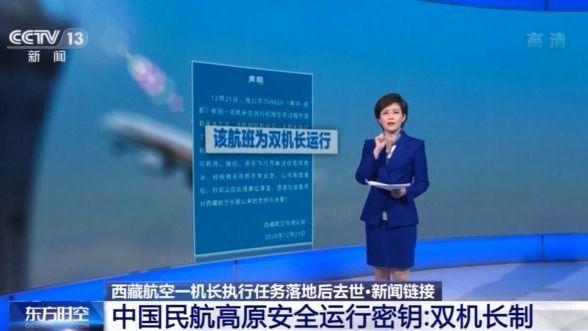One captain of Tibet Airlines dies after landing on mission. How does the “dual captain” system in the aviation industry operate?
Tibet Airlines issued a statement on the 23rd. On December 21st, a captain of the company's TV9820 Nanjing-Chengdu flight felt unwell during the flight mission. Another captain of the same flight crew performed follow-up. Flight mission.
The flight landed safely at Chengdu Shuangliu International Airport at 00:25 on December 22.
Subsequently, the captain was sent to the hospital for treatment, but unfortunately passed away at the age of 39.
Currently, Tibet Airlines is dealing with the aftermath. Tibet Airlines did not disclose the specific cause of the captain and the detailed process of more incidents.
We noticed a detail from this statement, that is, the flight is operated by two captains.
Some people may ask, why does a civil airliner have two captains?
Where is the main role of the two captains?
Next, we will learn more about the dual captain system.
In the Chinese aviation industry, dual captain operations are the key to the safe operation of Chinese civil aviation in the plateau.
The plateau airport refers to the airport with an altitude of 1524-2438 meters, and the high plateau airport refers to the airport with an altitude of 2438 meters and above. my country has the world's most high-altitude airports, including the world's highest altitude Daocheng Yading Airport, and Lhasa Gongga International Airport, Ganzi Kangding Airport and so on.
Both the plateau airport and the high plateau airport are collectively referred to as the plateau airport.
According to the advisory notice on "High-altitude Airport Operation" issued by the Civil Aviation Administration of my country, it is clear that a set of flight crews for high-altitude airport operations should be equipped with at least three pilots, and in addition to the captain, there should be one with at least corresponding qualifications. The senior co-pilot.
It is also necessary to be equipped with a cruise captain who will replace the captain in the cruise phase. This cruise captain "should be fully qualified to serve as the captain on this type of aircraft."
Based on this regulation, the current flights operating at the high plateau airport will be equipped with "double captains."
At the same time, every pilot of China's Civil Aviation who flies on plateau routes has undergone rigorous flight training and has the ability to deal with special situations at critical moments.
On May 14, 2018, during the emergency landing of Sichuan Airlines flight 3U8633, the front windshield of the right seat of the cockpit fell off, the co-pilot was injured, and many instruments were also damaged.
At a critical moment, the second captain Liang Peng entered the cockpit to take over the work of the co-pilot, and handled calmly and calmly with the responsible captain Liu Chuanjian, and finally made an emergency landing at Chengdu Shuangliu Airport, where all personnel landed safely.
This is also a testament to the tremendous role played by the "dual captains".
However, some people may ask, this time Tibet Airlines flight TV9820 is flying from Nanjing to Chengdu. These two airports are not plateau airports. Why are they equipped with dual captains?
In addition to the plateau airport, which airports and airlines are equipped with dual captain systems?
What are the considerations?
Which other airports and routes implement the "dual captain" system?
In addition to “dual captains” for high-altitude routes, China’s civil aviation will also implement the “dual captains” system for complicated routes. In addition, new passenger aircraft and new routes will also be equipped with “dual captains” to ensure safety.
What are the guarantees for the safe operation of special routes?
In addition to the "dual captain" system, what are the system guarantees for the safe operation of relatively special routes on plateaus, weather, and geographical conditions?
According to Wang Yanan, editor-in-chief of "Aviation Knowledge" magazine, in addition to strengthening the staffing guarantee work in all links, the requirements of each work process are also higher to ensure the safety of operations.

